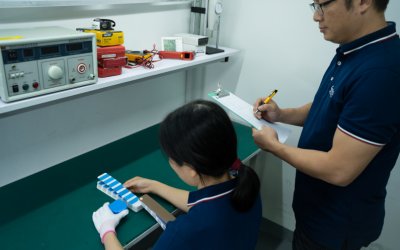If you want to have success as an importer, it’s important that your products live up to the quality standards you set for them.
If they don’t, it can lead to low customer satisfaction, excessive customer complaints, and high levels of returns.
Quality management is tricky, but with the right attitude, you can make it more likely that the products your customers receive are exactly as they (and you) expect.
There is a saying in the quality industry that, “Quality begins with the buy.”
Understanding and embodying this phrase is one of the most important keys to getting the quality you expect from your suppliers.
This means you need to:
- Think about how you will address the challenge of producing quality products early on, and
- Start taking actions to ensure the quality of your products before your factory ever begins production.
You can’t inspect quality into a product. You must be proactive and set your suppliers up for success. That means you need to set clear expectations at the time of order.
Setting Expectations With Your Factory is Important
If you don’t set clear expectations with your factory, it raises the probability of issues arising and the product not meeting your quality standards.
How do you set the proper expectations with your factory? Here are three ways.
#1 Provide a Bill of Materials and Specification Sheet
One important way to set expectations is to provide a Bill of Materials (BOM) and a Specification Sheet.
A Bill of Materials specifies all the raw materials and components that go into your product, along with their quantities. For example, a ballpoint pen has various parts such as the spring, push button, clip, ink cartridge, etc.
A Specification Sheet (or Spec Sheet) provides all possible details about your product, including its size, shape, volume, measurements, material specifics, colors, and anything else that is relevant.
Let’s say you are producing a 6×8 foot tarp with metal grommets. You might note in your spec sheet that the grommets are spaced 2 feet apart and that there are 24 grommets in total, covering 48 linear feet. You would also state that the grommets are made of 304 stainless steel. The more detailed you can be the better.
If you have a very simple product, you might not need a BOM, but a spec sheet should always be included with your order.
#2 Approval Samples or Material Samples
Another key is to have an approval sample, also known as a “golden sample.”
An approval sample is produced by the factory before production. It represents a perfectly produced item. Any future production unit can be compared to it in terms of quality. If the production unit is inferior to the golden sample, you can hold your factory accountable.
If you don’t have an approval sample, one alternative is to provide material samples to the factory. You can use your material samples in a similar way. This allows you to hold the supplier accountable for any inferior quality materials that end up in your production units.
#3 Notify Them in Advance That You May Conduct Inspections
When you place your order, be sure to inform your supplier that you may conduct product inspections at some point.
When you inform them of this, they become aware that they will be held to specific standards and that their work will be looked at closely prior to shipping.
Setting the proper expectations goes a long way. But, more than that, you need to carefully consider the relationship between cost and quality.
Never Forget the Relationship Between Cost and Quality
You want to save costs. But remember that trying to bend a supplier to your will can be a losing strategy.
If you try to beat them down on price and they agree to your demands, you may find that, eventually, something has to give. They may end up cutting corners without you realizing it, for example by using inferior materials. This can lead to unexpected problems with your product can have very real consequences for your business.
Rather than trying to bend them to your will, a better approach is to have an open dialogue with them about how to lower manufacturing costs.
This means working together to determine what components or materials you could substitute into your product while still maintaining quality. In our tarp example, perhaps you could use rubber grommets instead of steel ones. The rubber grommets would be less expensive while still offering good durability.
You can also consider using a lesser grade of a raw material such as a less expensive grade of steel. You can even consider using recycled materials.
One other thing to consider is placing your orders during off-peak times.
If you’re working with Chinese factories and placing orders too close to Chinese New Year, you may see higher costs. Placing an order in the spring, on the other hand, can sometimes even save you up to 40%.
The important thing to keep in mind is that you want to work with, rather than against, your factory.
Remember That Quality Begins With the Buy
As an importer, you have to be concerned about the quality of your products. So, always remember that quality cannot be inspected into them. Quality is something that you build into your product from the start.
Be proactive and take steps to set your factory up for success. Always set clear expectations with them and have an open and honest dialogue. Do not try to bend them to your will.
Following this advice will increase the likelihood that your shipments live up to your expectations.
For more information about the relationship between cost and quality, download our ebook, Price vs. Quality.
Price vs. Quality: What You Need to Know
Download our free white paper, Price vs. Quality, to learn how to produce great quality while keeping your costs low.





0 Comments